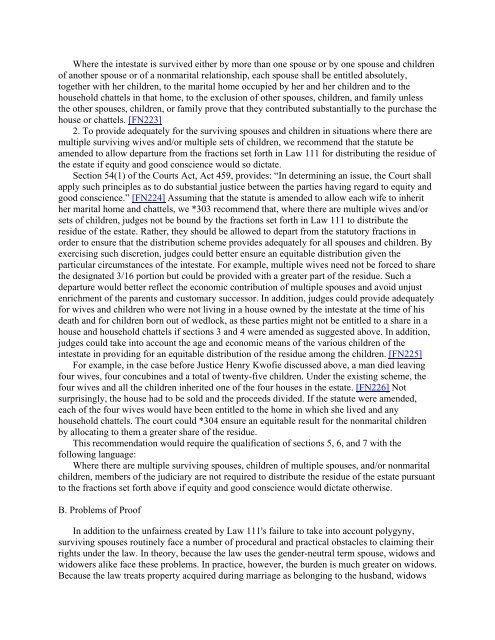Law, Culture and Women's Inheritance Rights in ... - Leitner Center
Law, Culture and Women's Inheritance Rights in ... - Leitner Center
Law, Culture and Women's Inheritance Rights in ... - Leitner Center
You also want an ePaper? Increase the reach of your titles
YUMPU automatically turns print PDFs into web optimized ePapers that Google loves.
Where the <strong>in</strong>testate is survived either by more than one spouse or by one spouse <strong>and</strong> children<br />
of another spouse or of a nonmarital relationship, each spouse shall be entitled absolutely,<br />
together with her children, to the marital home occupied by her <strong>and</strong> her children <strong>and</strong> to the<br />
household chattels <strong>in</strong> that home, to the exclusion of other spouses, children, <strong>and</strong> family unless<br />
the other spouses, children, or family prove that they contributed substantially to the purchase the<br />
house or chattels. [FN223]<br />
2. To provide adequately for the surviv<strong>in</strong>g spouses <strong>and</strong> children <strong>in</strong> situations where there are<br />
multiple surviv<strong>in</strong>g wives <strong>and</strong>/or multiple sets of children, we recommend that the statute be<br />
amended to allow departure from the fractions set forth <strong>in</strong> <strong>Law</strong> 111 for distribut<strong>in</strong>g the residue of<br />
the estate if equity <strong>and</strong> good conscience would so dictate.<br />
Section 54(1) of the Courts Act, Act 459, provides: “In determ<strong>in</strong><strong>in</strong>g an issue, the Court shall<br />
apply such pr<strong>in</strong>ciples as to do substantial justice between the parties hav<strong>in</strong>g regard to equity <strong>and</strong><br />
good conscience.” [FN224] Assum<strong>in</strong>g that the statute is amended to allow each wife to <strong>in</strong>herit<br />
her marital home <strong>and</strong> chattels, we *303 recommend that, where there are multiple wives <strong>and</strong>/or<br />
sets of children, judges not be bound by the fractions set forth <strong>in</strong> <strong>Law</strong> 111 to distribute the<br />
residue of the estate. Rather, they should be allowed to depart from the statutory fractions <strong>in</strong><br />
order to ensure that the distribution scheme provides adequately for all spouses <strong>and</strong> children. By<br />
exercis<strong>in</strong>g such discretion, judges could better ensure an equitable distribution given the<br />
particular circumstances of the <strong>in</strong>testate. For example, multiple wives need not be forced to share<br />
the designated 3/16 portion but could be provided with a greater part of the residue. Such a<br />
departure would better reflect the economic contribution of multiple spouses <strong>and</strong> avoid unjust<br />
enrichment of the parents <strong>and</strong> customary successor. In addition, judges could provide adequately<br />
for wives <strong>and</strong> children who were not liv<strong>in</strong>g <strong>in</strong> a house owned by the <strong>in</strong>testate at the time of his<br />
death <strong>and</strong> for children born out of wedlock, as these parties might not be entitled to a share <strong>in</strong> a<br />
house <strong>and</strong> household chattels if sections 3 <strong>and</strong> 4 were amended as suggested above. In addition,<br />
judges could take <strong>in</strong>to account the age <strong>and</strong> economic means of the various children of the<br />
<strong>in</strong>testate <strong>in</strong> provid<strong>in</strong>g for an equitable distribution of the residue among the children. [FN225]<br />
For example, <strong>in</strong> the case before Justice Henry Kwofie discussed above, a man died leav<strong>in</strong>g<br />
four wives, four concub<strong>in</strong>es <strong>and</strong> a total of twenty-five children. Under the exist<strong>in</strong>g scheme, the<br />
four wives <strong>and</strong> all the children <strong>in</strong>herited one of the four houses <strong>in</strong> the estate. [FN226] Not<br />
surpris<strong>in</strong>gly, the house had to be sold <strong>and</strong> the proceeds divided. If the statute were amended,<br />
each of the four wives would have been entitled to the home <strong>in</strong> which she lived <strong>and</strong> any<br />
household chattels. The court could *304 ensure an equitable result for the nonmarital children<br />
by allocat<strong>in</strong>g to them a greater share of the residue.<br />
This recommendation would require the qualification of sections 5, 6, <strong>and</strong> 7 with the<br />
follow<strong>in</strong>g language:<br />
Where there are multiple surviv<strong>in</strong>g spouses, children of multiple spouses, <strong>and</strong>/or nonmarital<br />
children, members of the judiciary are not required to distribute the residue of the estate pursuant<br />
to the fractions set forth above if equity <strong>and</strong> good conscience would dictate otherwise.<br />
B. Problems of Proof<br />
In addition to the unfairness created by <strong>Law</strong> 111's failure to take <strong>in</strong>to account polygyny,<br />
surviv<strong>in</strong>g spouses rout<strong>in</strong>ely face a number of procedural <strong>and</strong> practical obstacles to claim<strong>in</strong>g their<br />
rights under the law. In theory, because the law uses the gender-neutral term spouse, widows <strong>and</strong><br />
widowers alike face these problems. In practice, however, the burden is much greater on widows.<br />
Because the law treats property acquired dur<strong>in</strong>g marriage as belong<strong>in</strong>g to the husb<strong>and</strong>, widows


